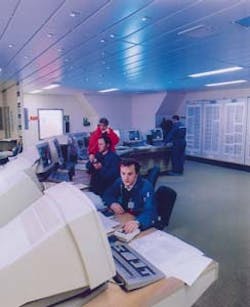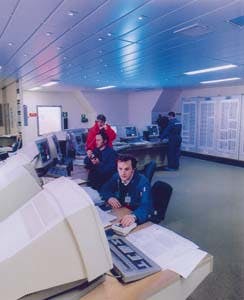SAFETY Kvaerner FSSL integrates control of Andrew operations
Control room as supplied to the BP Andrew Field platform.
BP UK's Andrew Field, due to be in service this summer, will feature the first integrated control, monitoring and safety system (CMSS) for both platform and subsea installations. The system, designed by the Industrial Computer Applications (ICA) division of Kvaerner FSSL, Aberdeen, is based around a common Siemens hardware platform comprising PLCs for control and PC operator stations. Andrew's control requirements have also been configured using Siemens' Applications Productivity Tool (APT), designed specifically for control systems and covering activities from PLC programming to man machine interface.
APT allows the user to implement process control needs rapidly in a structured and object-oriented manner. It provides seamless integration between PLCs and the operator interface as well as a common programming tool across all applications, whether process or safety related.
The CMSS handles the entire process control functions on the Andrew platform as well as the subsea control functions on the Cyrus Field. Its role is to monitor the process characteristics, keep them within prescribed limits and provide operators with status reports. This covers all process packages.
The Emergency Shutdown System (ESD) monitors platform process conditions and initiates an orderly shutdown when hazardous conditions are detected; manual initiation is also possible from the central control room or drilling module. It also isolates reservoir risers and major inventories and depressurizes gas inventories. The aim is to prevent process plant failure, hydrocarbon release or catastrophic failure, and to limit the inventory exposed to potential hazard.
The Fire and Gas System (F&G) monitors the plant for the presence of fire and gas, initiates the release of extinguishant and provides audible and visual indications of a hazard. Fire water ring main and fire pump control logic is also incorporated in the system, including a dedicated hardwired mimic on the F&G matrix panel.
Each part of the CMSS - ESD, F&G and so on - is physically segregated and powered by separate power supplies.
According to Kvaerner FSSL, use of common technology helps to reduce costs in a number of ways:
- PLC and PC technologies are high-volume and hence low cost.
- CMSS, ESD and F&G are manufactured by one rather than up to three suppliers, which reduces technical interface management problems for the project design team.
- Documentation is cut: a single rather than multiple document is produced.
- Synergy of operator interface is provided: control rooms operators use a single style of VDU-based interface rather than having to master several different interfaces.
Using standard products also minimizes the need for special design work and cuts architecture costs substantially. A further aim has been to diminish complexity of the ESD and F&G systems, thereby minimizing the amount of special project work.
An integrated CMSS also allows the use of appropriate design and configuration tools in a unified, consistent manner, often automating generation of standard operator interface database and graphics. Used properly, this can cut development time.
Finally, says Kvaerner FSSL, an integrated CMSS adds flexibility to the platform's commissioning phase. Provided the integrated CMSS is in a fully tested form prior to use, it will reduce the number of skilled personnel required by the completion team during the commissioning phase.
It will also provide improved operation of any changes to the control strategy that may be needed during commissioning. Spares holding is minimized and post-commissioning service and support is more readily achieved using multi-skilled technicians.
Copyright 1996 Offshore. All Rights Reserved.

